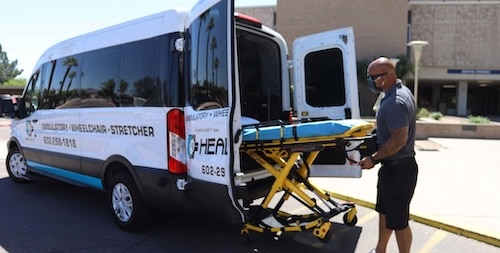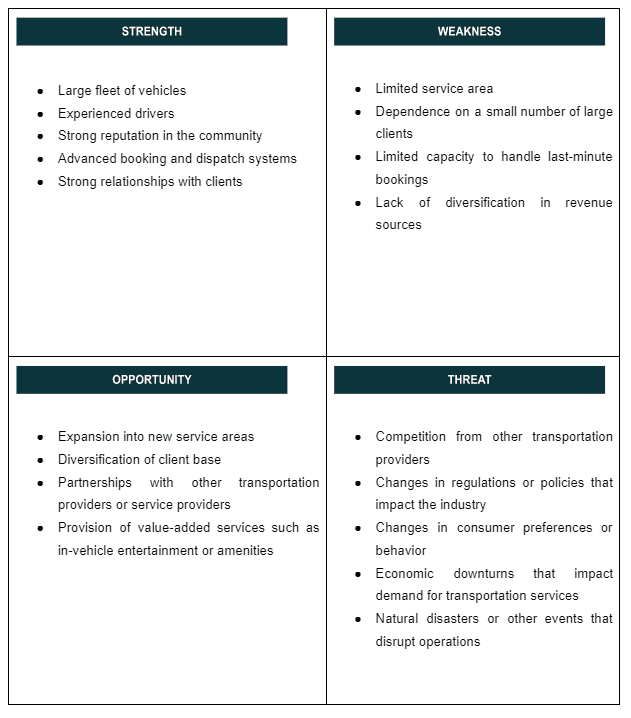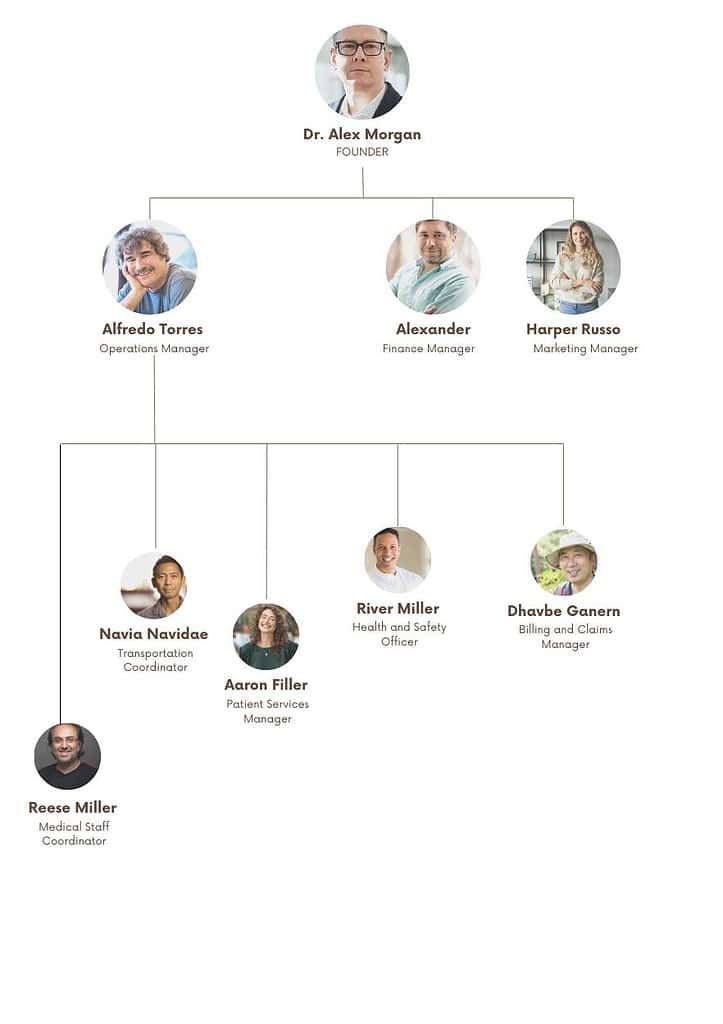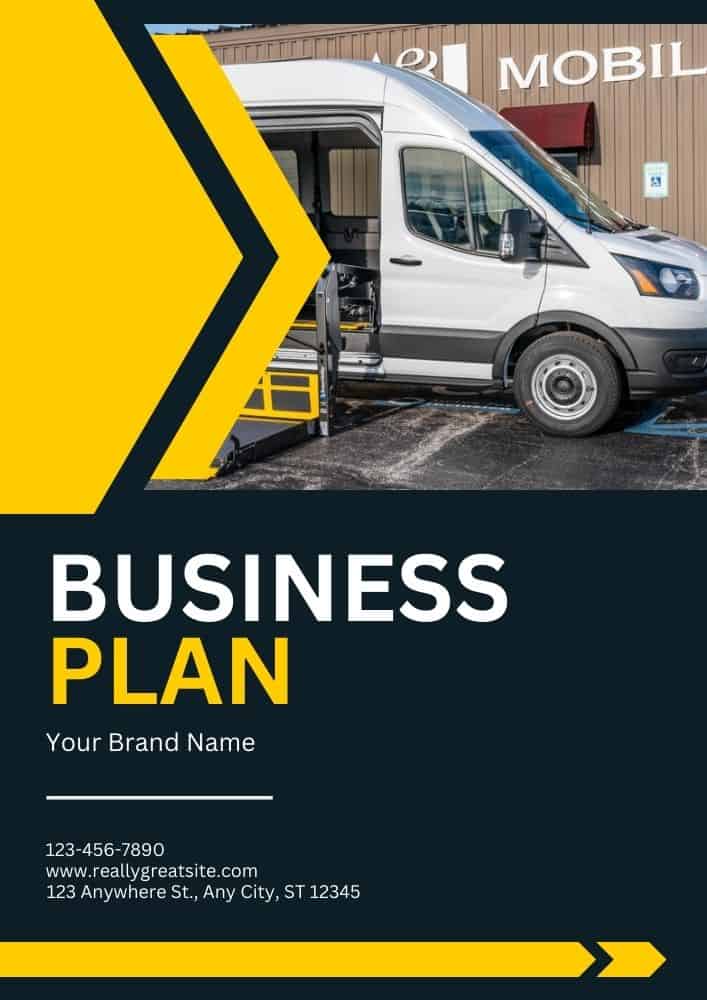Written by Elma Steven | Updated on April, 2024

How to Write a Non Emergency Medical Transportation Business Plan?
Non Emergency Medical Transportation Business Plan is an outline of your overall Non Emergency Medical Transportation business. The business plan includes a 5 year projection, marketing plan, industry analysis, organizational overview, operational overview and finally the executive summary. Remember to write your executive summary at the end as it is considered as a snapshot of the overall business plan. The creation of a plan requires careful consideration of various factors that might impact the business’s success.
Table of Contents
Executive Summary
The HealthBridge Care Services founded by Dr. Alex Morgan in Michigan during the year 2014 provides reliable and accessible transportation services for individuals with mobility challenges. We offer transportation solutions for non-emergency medical appointments, social outings and daily errands. We prioritize safety, punctuality, and exceptional customer service with a fleet of accessible vehicles and trained drivers.
Mission: “Our mission at HealthBridge Care Services is to provide safe, reliable, and accessible transportation to individuals in need. We are committed to delivering exceptional customer service and going above and beyond to meet the unique transportation needs of our clients.”
Vision: “Our vision at HealthBridge Care Services is to be the premier provider of safe and reliable transportation for those in need, constantly striving to improve and expand our services to better serve our community”
Industry Overview: The market for non-emergency medical transportation (NEMT) is expanding swiftly in the United States. Through 2028, the NEMT market is anticipated to be worth $22.4 billion up from $13.5 billion in 2021. Between 2016 and 2030, there is an anticipated 46% increase in the population of Americans aged 65 and older. As a result of mobility issues and other health conditions this demographic is more likely to require NEMT services. The prevalence of chronic illnesses including cancer, heart disease, and diabetes, is increasing. The increased need for NEMT services may result from the frequent medical appointments and remedies that these conditions frequently necessitate. Taxi companies, ambulance companies, and specialized NEMT providers are all included in the diverse NEMT industry. Transportation to and from medical appointments, dialysis appointments, and physical therapy appointments are among the many services that NEMT providers typically provide. Stretcher transportation and wheelchair transportation are a few of the additional services that they might provide. Check out this guide on how to write an executive summary? If you don’t have the time to write on then you can use this custom Executive Summary Writer to save Hrs. of your precious time.
Financial Overview:
Business Description
Business Name:
Founders:
Management Team: [You can ignore this/ delete this but its better to provide it]

Legal Structure: [e.g. LLC]
Location: Michigan
Goals:
✔️Increasing profitability by optimizing routes, reducing fuel costs, and maximizing utilization of vehicles.
✔️Expanding the business by adding new vehicles and services, such as delivery or shuttle services.
✔️Building a strong brand and reputation through excellent customer service and high-quality vehicles.
Products:
✔️Hourly Rates
✔️Flat Fees
✔️Subscription Packages
Financial Overview
Fund Usage
Key Metrics:
Business Model Canvas
It comprises nine key components – customer segments and value propositions to revenue streams and cost structures. The canvas provides a clear and concise way to map out, analyze, and communicate the intricacies of a business idea. It offers a holistic view of how a business creates, delivers, and captures value. It also aids entrepreneurs in refining concepts, fostering innovation, and making informed strategic choices. It serves as a versatile tool for brainstorming, planning, and presenting business models to stakeholders. Check out 100 samples of business model canvas.

SWOT
A SWOT analysis is integral to the Non Emergency Medical business plan. it offers a clear lens into a company’s strengths, weaknesses, opportunities, and threats. This self-awareness enables effective resource allocation and strategic positioning against competitors. Businesses can mitigate risks, make informed decisions, and set realistic goals. In addition, presenting a SWOT analysis in a business plan communicates to stakeholders that the company possesses a deep understanding of its market environment. In essence, SWOT ensures a business’s strategy is grounded in reality enhancing its chances of success. Check out the 100 SWOT samples which will give you a better idea on SWOT writing process.

Organizational Overview
Organizational overview provides a snapshot of how a company is structured and operates. It outlines the ownership structure, roles, responsibilities of key management personnel, and the reporting hierarchy within the organization. This section offers stakeholders, investors and other readers a clear understanding of the company’s leadership and its chain of command. Additionally, it may give insight into the company’s culture, values and operational philosophy.
Founder

Dr. Alex Morgan, Founder & CEO, HealthBridge Care Services
Dr. Alex Morgan, an accomplished medical professional with more than 15 years of experience, is a pioneer in the development of non-emergency medical treatment. Dr. Morgan graduated from the esteemed Johns Hopkins University with a medical degree and concluded his geriatric care-focused residency in internal medicine at the Mayo Clinic. Dr. Morgan has played a pivotal role in influencing policies and practices that place a premium on patient comfort and accessibility, by virtue of their empathetic approach and unwavering commitment to patient-centered care.
Dr. Morgan established HealthBridge Care Services subsequent to his tenure as the chief physician at a highly regarded outpatient clinic, where they led endeavors to enhance the accessibility and coordination of patient care. Their efforts in establishing community-based health initiatives received widespread recognition on a national level, underscoring the criticality of comprehensive healthcare alternatives to conventional hospital environments for managing chronic conditions.
Motivated by an individual objective to establish a connection in healthcare accessibility, Dr. Morgan established HealthBridge Care Services with the overarching goal of delivering exceptional, compassionate medical services to individuals requiring non-urgent medical attention. By integrating state-of-the-art technology with a personalized approach, HealthBridge has established itself as an exemplar of inventive, patient-centric healthcare under their direction.
Community involvement is an aspect of Dr. Morgan’s existence that transcends their professional obligations. They volunteer frequently at local health festivals and clinics and are prominent members of a number of healthcare committees. Inspiring future generations of healthcare professionals, their fervor for education has additionally propelled them to deliver guest lectures at medical institutions.
Dr. Morgan, a highly regarded authority in the discipline, persistently champions progress in non-emergency medical care, thereby guaranteeing that HealthBridge maintains its leading position in the provision of high-quality and empathetic hospitals.
Organogram

Staff Positions
Spending on Management & Operations:
Spending on Marketing & Sales:
Spending on Finance & Accounting:
Industry Analysis
Industry Overview
According to a report by the World Health Organization (WHO), the demand for non emergency medical transportation services is likely to increase in the coming years due to a number of factors, including an aging population, increasing rates of chronic diseases, and urbanization. The report estimates that the global market for non emergency medical transportation services could be worth around $10 billion by 2020.
Problems & Opportunities
✔️Driver retention: Recruiting and retaining skilled and reliable drivers can be a challenge, particularly in a competitive job market.
✔️Client satisfaction: Ensuring the satisfaction of clients is critical for the success of a non emergency medical transportation business. This can include factors such as the safety and comfort of the vehicles, the professionalism and friendliness of the drivers, and the reliability of the service.
✔️Regulations: The non emergency medical transportation industry is subject to various regulations, including those related to vehicle safety, driver qualifications, and insurance requirements. Staying up to date with these regulations and ensuring compliance can be a challenge.
✔️Partnerships: The business could consider partnerships with other transportation providers or service providers, such as hospitals or senior living facilities, to expand its client base and generate new revenue streams.
✔️Value-added services: The business could consider offering value-added services to clients, such as in-vehicle entertainment or amenities, to differentiate itself from competitors and increase revenue.
✔️Technology: Incorporating technology, such as GPS tracking or telematics systems, could improve the efficiency and reliability of the transportation service.
Target Market Segmentation
Geographic Segmentation:
✔️Local Residents: Tailor services to the local market, understanding and incorporating local healthcare infrastructure and preferences.
✔️Non-Local Customers: Cater to clients visiting from other areas or those needing long-distance transportation possibly partnering with healthcare facilities in different regions.
Demographic Segmentation:
✔️Age: Older customers (e.g. seniors, people over 65) are likely to be the primary target market for non emergency medical transportation business, as they are more likely to have mobility issues or to be unable to drive themselves.
✔️Gender: A non-medical transportation business might cater to both men and women, or it might focus on one gender in particular. For example, a non-medical transportation business might offer special services or amenities that are more appealing to women (e.g. car seats for young children, assisted travel services).
✔️Income: Higher-income customers might be willing to pay more for premium transportation services, while lower-income customers might be more price-sensitive.
✔️Education: Customers with higher levels of education might be more interested in learning about the latest transportation technologies and services, while less educated customers might be more focused on the practical benefits of the services.
✔️Occupation: Customers who have busy, high-stress jobs might be more interested in transportation services that are convenient and efficient, while customers with more leisurely lifestyles might be more interested in transportation services that offer additional amenities or a more relaxing experience.
Psychographic Segmentation:
✔️Personality: Customers who are concerned about their safety and are willing to invest in reliable transportation services might be more likely to use a non-medical transportation business, while customers who are less concerned about their safety might be less likely to use a non-medical transportation business.
✔️Values: Customers who place a high value on independence and self-sufficiency might be more likely to use a non-medical transportation business, while customers who value affordability and practicality might be less likely to use a non-medical transportation business.
✔️Attitudes: Customers who have a positive attitude towards non-medical transportation services (e.g. see them as a safe and convenient way to get around) might be more likely to use a non-medical transportation business, while customers who have a negative attitude towards non-medical transportation services (e.g. see them as unnecessary or overly expensive) might be less likely to use a non-medical transportation business.
✔️Interests: Customers who are interested in travel and adventure might be more likely to use a non-medical transportation business that offers assisted travel services, while customers who are more interested in relaxation and comfort might be more likely to use a non-medical transportation business that offers luxury amenities.
✔️Lifestyle: Customers with busy, high-stress lifestyles might be more likely to use a non-medical transportation business as a way to save time and reduce stress, while customers with more relaxed, leisurely lifestyles might be more likely to use a non-medical transportation business as a way to enjoy a more enjoyable and convenient transportation experience.
Behavioral Segmentation:
✔️Occasion: Customers who use non-medical transportation services on a regular basis might be more likely to use non-medical transportation services that offer loyalty programs or discounts for frequent users, while customers who use non-medical transportation services less frequently might be more likely to use non-medical transportation services that offer one-time services or package deals.
✔️Benefits sought: Customers who value convenience might be more likely to use non-medical transportation services that offer mobile or home services, while customers who value a luxurious experience might be more likely to use non-medical transportation services that offer a range of amenities such as massage or entertainment.
✔️User status: Customers who are first-time non-medical transportation users might be more likely to use non-medical transportation services that offer help or assistance for choosing services, while experienced non-medical transportation users might be more comfortable making their own decisions.
✔️Usage rate: Customers who use non-medical transportation services frequently might be more likely to use non-medical transportation services that offer bulk discounts or loyalty programs, while customers who use non-medical transportation services less frequently might be more price-sensitive.
✔️Attitude towards the product or service: Customers who have a positive attitude towards non-medical transportation services might be more likely to use non-medical transportation services that offer a range of services and amenities, while customers who have a negative attitude towards non-medical transportation services might be less likely to use non-medical transportation services.
Market Size
✔️Total Addressable Market: TAM refers to the total demand for a product or service in a specific market. It represents the entire market size without any limitations, assuming there are no constraints or barriers to adoption. TAM represents the maximum revenue opportunity available for a product or service if it were to capture 100% market share. If we assume that a significant portion of the population requires non-medical transportation services at some point, the TAM would be the potential market size of those 1 million people. So, our TAM is $1M.
✔️Serviceable Addressable Market: SAM represents the portion of the TAM that a business can realistically target and serve. It takes into account factors such as geographical limitations, target customer segments, and other constraints that may affect the business’s ability to reach the entire market. SAM represents the market segment that aligns with the business’s value proposition and is accessible to the company. Let’s assume that the non-medical transportation business can effectively target and serve 30% of the total market demand, then our SAM is $300K.
✔️Serviceable Obtainable Market: SOM is an even smaller subset of the SAM and represents the portion of the SAM that a company can realistically capture or obtain. It considers the market share that a company can actually achieve in its target market given its strategies, competition, and other factors. Let’s assume the non-medical transportation business aims to capture 20% of the SAM. So, the estimated SOM is $60K.
Competitive Landscape
Industry Forces
✔️Market Demand and Entertainment Trends: Variations in healthcare needs, demographic shifts (like an aging population) and the rise in chronic diseases are primary drivers of demand in the NEMT market.
✔️Competition: The NEMT market experiences competition influenced by factors such as the quality of service, range of transportation options offered (like wheelchair-accessible vehicles) and pricing.
✔️Technological Advancements: From advanced scheduling and routing software to the use of GPS and vehicle tracking technologies plays a crucial role in the NEMT industry. Implementing these technologies can improve service efficiency and customer experience.
✔️Regulatory Environment: Compliance with healthcare and transportation regulations, including those related to patient safety, vehicle standards and driver qualifications is critical.
✔️Economic Factors: The NEMT industry needs to offer services that cater to different economic segments from basic transportation options to more premium services ensuring accessibility to a diverse client base regardless of their financial status.
Marketing Plan
Marketing Budget
Total budget for projected years:
Budget allocation across channels:
Marketing Channels
We plan to use the following promotional tactics:
✔️Local Business Directories and Listings: Register your non-medical transportation business in online directories and local business listings.
✔️Search Engine Optimization (SEO): Optimize your website and online content to rank higher in search engine results.
✔️Online Advertising: Run targeted online advertising campaigns through platforms such as Google Ads, Facebook Ads, or local advertising networks..
✔️Social Media Marketing: Utilize popular social media platforms like Facebook, Instagram, and Twitter to promote your non-medical transportation services.
✔️Referral Programs and Word-of-Mouth: Encourage satisfied clients to refer your services to their friends, family, and acquaintances.
✔️Partnerships and Networking: Establish partnerships with local senior centers, retirement communities, healthcare facilities, or event venues.
✔️Local Community Involvement: Sponsor local events, fundraisers, or community programs to increase your visibility and demonstrate your commitment to the community.
Financials
Earnings
Liquidity
Income Statement

Balance Sheet

Cash Flow Statement

Revenue Summary

Cost Summary

Loan Amortization Schedule

Salary Summary

Non-Current Asset Schedule


